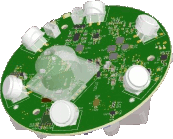What Customers are Saying About Golden Gate Graphics PCB Design
- "Reliable, precise and meticulous; our large, complex design was virtually error free the very first iteration."
~Phil C, Electrical Engineer. - "Our board for the International Space Station has been in service since 2003 with no hardware failures. In fact, all the designs you did for me were all single-rev."
~BSZ, Senior Systems Engineer, RT Logic.
WHAT AN ELECTRICAL ENGINEER WANTS
A Message to PCB Designers
Any electrical engineer wants the printed circuit to match the schematic. Any artwork that really duplicates his or her intentions will embody this. It has often been said this way: "The schematic is the Bible."
"Bible" is a metaphor for "Stable Datum."
A stable datum is a datum along which all other data align. From any confusion, order and sanity can emerge providing one merely selects a datum, assigns it importance or seniority and then begins to align other data against it.
The stable datum for printed circuit design is this: If it says it is such a way in the schematic, then that is the way it must be in the PCB layout. The schematic contains the stable data with which the printed circuit layout data must align.
Another example of a stable datum: Our stable datum for PCB CAD software is "At Golden Gate Graphics, we use the latest Altium Designer, which currently is version 25."
The primary alignment of data that has to occur here is electrical. If the schematic says connect pin 13 of U2 to pin 2 of U1, then the PCB layout had better provide for a copper trace that
-
goes ALL the way from U1 pin 2 to U2 pin 13,
-
is wide enough to be manufacturable and carry the current required and
-
does not touch or get closer than a minimum air gap to any other conductor.
There is an additional mechanical aspect in the alignment of PCB layout data to the stable data of the schematic. If the footprint as laid out for U2 is wrong, it will not accept the actual part for soldering, so there is no direct way for its pin 13 to get to U1 pin 2. This aspect requires a bit more information than just the schematic. The schematic says U2 is say, a quad nor-gate. It may also specify which footprint the device is packaged into, such as a 14-pin DIP . Often such information is not visible, but internal to the schematic file. So the PCB designer will need that additional information from the electrical engineer, who could extract it as part of a BOM and supply mechanical information as well by means of a specifications sheet, "spec sheet" or "datasheet."
These two areas of duplication of the schematic are always what an electrical engineer wants. He wants all the parts he buys to fit on the board, and he wants the connections to match his schematic. Anything else he wants, he'll either expect you to know as part of the basics of PCB design or he'll tell you.
If he doesn't get these two things from the PCB designer, then he can't examine his own circuit design in practice until he makes the prototype PCB match his own schematic by means of cuts and jumpers. But he shouldn't have to do such rework; the PCB designer should have done his job right in the first place.
The more insidious error is one of connectivity. A part that doesn't fit is an obvious error. Now suppose that everything looks fine, but one or more connections go to different places than the schematic says they should. If the engineer doesn't do a line-by-line check of the layout, then the errors enter into the prototype board, which doesn't function as expected. Then the engineer has to find out that the PCB design didn't match his schematic and fix that with cuts and jumpers until it does. Only then can he debug his own design flaws. Most engineers aren't going to be happy about doing this, although some are quite gracious and are used to it.
For "Streamlined PCB Design" to mean anything at all, it would have to guarantee that the connectivity of the PCB exactly matches, or "perfectly duplicates" that of the schematic.
And then we come to one final thing that a "double-E" wants from a PCB designer, and that is not to be robotic about the PCB matching the schematic. If the PCB designer notices something unusual or ambiguous about the schematic, he should talk to the engineer about it. An engineer will certainly appreciate any of his own errors or omissions being caught before the prototype is built.
A common example of a schematic error is omitted bypass caps on simple logic devices. This can occur because the default logic symbols for the parts often don't include the power and ground connections at the corner pins (for example pins 7 for ground and pin 14 for power in a 14-pin device), so the bypass caps can get overlooked. Most engineers will want the PCB designer to point out the omission and ask if he wants to add the bypass caps. They coordinate on reference designators , the engineer updates his schematic, and the printed circuit artwork (PCB design) remains true to the concept that the schematic represents the stable data.
Now there is one additional caveat to all this. When I say the electrical engineer wants the printed circuit to match his schematic, I'm talking about the hard copy of the schematic. In past years, especially involving certain varieties of software, we found that, unfortunately, the schematic computer files could be quite different internally from the hard copy. That is why we would always check the netlist extracted from the schematic database against the hard copy. We had on occasion found quite a disparity between the two. We would rarely, extremely rarely, find nothing to correct from our netlist check. As Rosanne Rosannadana used to say, "There's always somethin'."
However, our designers use schematic software that reliably produces netlists that perfectly match the hard-copy of the schematic, without exception. They have also applied "Streamlined PCB Design" to really make the schematic follow the policy: "The schematic is the bible." Because of that, we no longer routinely check every line of the hard copy of the schematic against a netlist unless the customer requests that. Rather, we find time is now better spent by insuring that the engineer and his team, in their final checks, go through the schematic one last time in detail to look for any items they may have missed. It is best if the engineer checks the schematic line-by-line while a team mate checks the netlist. This is how the engineer can discover mistakes or possible improvements to the schematic, even if he finds no discrepancies between the netlist and the schematic.
The software we use coupled with our design policies have unfailingly produced manufacturable PCB artwork that matches the schematic.
Here is an example of Streamlined PCB Design of the schematic in operation: Usually there are at least transistor pin-outs to correct. Many engineers use a handful of generic logic symbols (in their schematics) for the myriad of possible components.1 This is fine for them, but the PCB designer then has to really nail down the pin-outs by examining spec sheets. Also, some transistor packages have a group of pins connected to the same net , but the schematic may show this as only one pin.
An electrical engineer should be so lucky as to have as a PCB designer one who was trained in Streamlined PCB Design doing his schematics: All of the CAE schematic from the beginning of the design. It is in this arena, end-to-end design, where Streamlined PCB Design can go into full swing and create a schematic that truly is the "bible." Once the details of proper pin-outs, PCB footprints and the nuances of a schematic designed with "Steamlined Design" are all in place, then everything downstream from the schematic is set up to also be streamlined: Fast, accurate and cost-effective.
_______________________________________________
1Technical Footnote:
The practice of using a library of generic logic symbols for the myriad of possible components in a schematic is commom, but is bad design and is not an example of streamlined end-to-end design. A major feature of our version of end-to-end design is this policy:
If it is a unique part in the Bill of Materials, it is a unique part in the library.
Furthermore, we add this maxim: The schematic library is the Bible for the schematic.
And then, from there, the schematic is the Bible for the PCB design.
This policy is the foundation for streamlining the schematic. One feature of this is that the name of the part in the library follows a nomenclature that is intuitive and that makes it easy to quickly find the part when one is ready to place a symbol in the schematic. It also makes it easy to tell if the part has not yet been added to the library. Here is an example of a resistor name (yes, each value of resistor is assigned its own library reference symbol): RES 3.01M 1/10W 1% 0603
Once this policy is firmly in place, any useful data desired can be included in the attributes of the library's components: The attributes only have to be researched once and from then on are included every time a symbol is placed in the schematic. This makes BOM creation work like it is supposed to and brings to mind the old expression: "We're cookin' with gas now!"
Get a quote: : sales
Related topic: Electronic project revisions and streamlined schematics.
© 1999-2009 John Walt Childers, IPC-CID. All Rights Reserved. Revised Friday, May 22, 2009.
Contact the author: : John Walt Childers, IPC-CID
Call us +1 (720) 276-9127
Golden Gate Graphics, Aurora, Colorado 80014, USA




